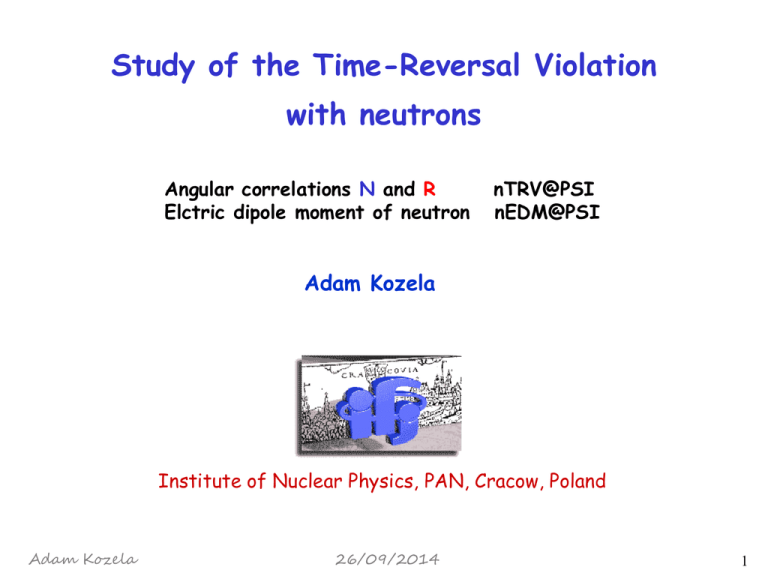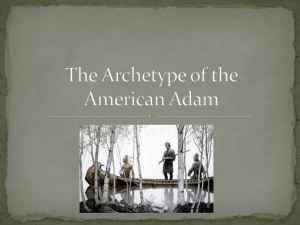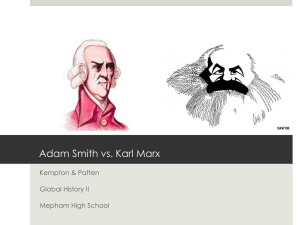Study of the time reversal violation with neutrons
advertisement

Study of the Time-Reversal Violation with neutrons Angular correlations N and R Elctric dipole moment of neutron nTRV@PSI nEDM@PSI Adam Kozela Institute of Nuclear Physics, PAN, Cracow, Poland Adam Kozela 26/09/2014 1 T- and CP-violation Theories Observations II Low of Thermodynamics - „arrow of time” Byron Asymmetry of the Universe. Kaon decays: KL -> ππ (1964). First observation of CP violation, (1988, NA31) CP violation in CKM matrix, 3rd generation of quarks and imaginary phase δKM, difference in decay of KL, KS to π0 π0 i π+ π- . Direct violation of T in kaon decays: o (1998, CPLEAR, CERN), o (2000, KTeV, Fermilab), KL-> π+ π- e+ e- . interaction allows for CP violation without Many observations of CP violation in the decays flavour change. of B mesons (BaBar, SLAC), (Belle, KEK). Recently: CP violation in the decay of D0 (LHCb). θ therm in effective Lagrangian of strong Direct observation of T-violation in entangled BB meson system. Adam Kozela Imaginary parts of coupling constants in weak interaction. 26/09/2014 Final state interaction. 2 Why neutron? It is neutral… (application of high electric fields possible). Long lifetime (886 sec, good and bad…). Decays by weak interaction (known from TRV). No effects from nuclear or atomic structure (for free neutrons exact value of MF, MGT). Small decay asymmetry A and small charges involved in decay => (small and precisely known final state interaction correction). Made of u and d quark (very small effect from KM-matrix). Adam Kozela 26/09/2014 3 Angular correlation in neutron decay Pp Jn (~885.7s) σT1 n -> p eνe + 782 keV se p σT2 p Tp=-p Ts=-s TJ = - J A- decay asymmetry (-0.1173) R, N – Correlation coefficients Adam Kozela 26/09/2014 4 Korelacje kierunkowe w rozpadzie neutronu Pp Jn σT1 se σT2 p p PDG: W ( , J , s , E , E , p , p ) 1 a p p E E m b E p p p p p p p s G H K L E E E m E E E E p A p B p C p D p p j E E Ep E E J p p s p s s p p p N s Q R Ss T p j E E E m E E E E E J s p s p p p p s U p V W j E E E E E E m J Adam Kozela 26/09/2014 5 Correlation coefficients N, R and exotic interactions Contribution from complex phase δKM and θ-term negligible (~10-12). Allowing for nonzero exotic couplings in weak interaction (Jackson, 57): NFSI~0.068 6∙10-4 RFSI~0.0006 6∙10-6 Beyond Standard Model: S, T – relative strength of scalar and tensor couplings Standard Model Final state interaction N measurement: detector test (Re(S), Re(T) known well from other experiments). If measured R≠0 Im(C Adam Kozela S) i Im(CT). new mechanism of T-(CP) violation, limit on 26/09/2014 6 Experimental setup (Mott Polarimeter), top view n V-track Adam Kozela 26/09/2014 7 Correlation coefficients N and R our result NFSI~0.0686∙10-4 RFSI~0.00066∙10-6 Former limmitations NSM·100 N ·100 RSM·100 R·100 T 68 Adam Kozela 62115 26/09/2014 0.6 4125S C T C 'T CA C S C 'S CV 8 Correlation coefficients N and R our result NFSI~0.0686∙10-4 RFSI~0.00066∙10-6 Former limmitations And our result [Phys. Rev. C 85, 045501] T S N = (62115)·10-3 Adam Kozela C T C 'T CA C S C 'S CV R = (4125)·10-3 26/09/2014 9 Correlation coefficients N and R, our result First measurement of correlation coefficients R i N in neutron decay is consistent with Standard Model expectations and with Time Reversal Symmetry. T S N = (62115)·10-3 Adam Kozela C T C 'T CA C S C 'S CV R = (4125)·10-3 26/09/2014 10 Electric Dipole Moment Simple case: Particle with spin: + Q e -Q + _ _+ Adam Kozela _ + Electric dipole moment of particle with spin Violates both Parity and time Reversal Symmetry 26/09/2014 11 nEDM – predictions θ-term from QCD Lagrangian: even ~10-18 e·cm. nEDN [e·cm] ~10-9 „Strong CP-problem” Current limit: 2.9·10–26 e·cm. nEDM@PSI final goal: 5·10-28 e·cm Contribution from complex phase δKM negligible below ~10-32 e·cm. Adam Kozela 26/09/2014 12 nEDM current precision dn=(+0.2 ± 1.5 ± 0.7)·10-26 e·cm. d ≈ 2 µm Adam Kozela 26/09/2014 n 13 nEDM @ Paul Scherrer Institute [successor of RAL,Sussex,ILL] Ramsey resonance method of separate oscillating fields applied for Ultra Cold Neutrons. UCN; v<10m/s Adam Kozela 26/09/2014 14 Ramsey resonance method of oscillating fields - principle Sample of polarized neutrons In constant, uniform fields B (1 μT) and E (12 kV/cm). 1. RF „π/2” pulse (30 Hz). 2. E 3. or Free precession of neutron spin T ~ 150200 s. E↑↑B: ωL+ = 2/ћ(μnB + dnE) E↑↓B: ωL- = 2/ћ(μnB - dnE) dn = ћ/4 ∙Δω/E 4. Second „π/2” pulse. 5. Analysis of neutron polarization. Adam Kozela 26/09/2014 15 Ramsey resonance method of oscillating fields - principle C1 dn ( ) 4E Statistical uncertainty: s (d n ) C2 Adam Kozela 26/09/2014 2 ET N where: visibility x – working points C1 C 2 C1 C 2 E: electric field intensity, T: free precession time N: number of neutrons counted after T. 16 nEDM @ PSI improvements UCN source, 1000 UCN/cm3 Magnetometry and magnetic field control Solid D2,30l,~5K • • • • Adam Kozela New shielding Surrounding Field Compensation New co-magnetometers… … 26/09/2014 17 Adam Kozela 26/09/2014 18 Współczynniki korelacji N i R a amplitudy wymiany leptokwarków d X -1/3 u e spin 0 1 2/3 F f 1/3 H h d X e u 2/3 e Q e Wcześniejsze ograniczenia i nasz rezultat LQ-wektorowe N = 62115 Adam Kozela R = 4125 26/09/2014 19 Minimalny Supersymetryczny Model Standardowy z łamaniem parzystości R e ~ e L e d u d ~ dR u e R = 4125 e N = 62115 Adam Kozela 26/09/2014 20








